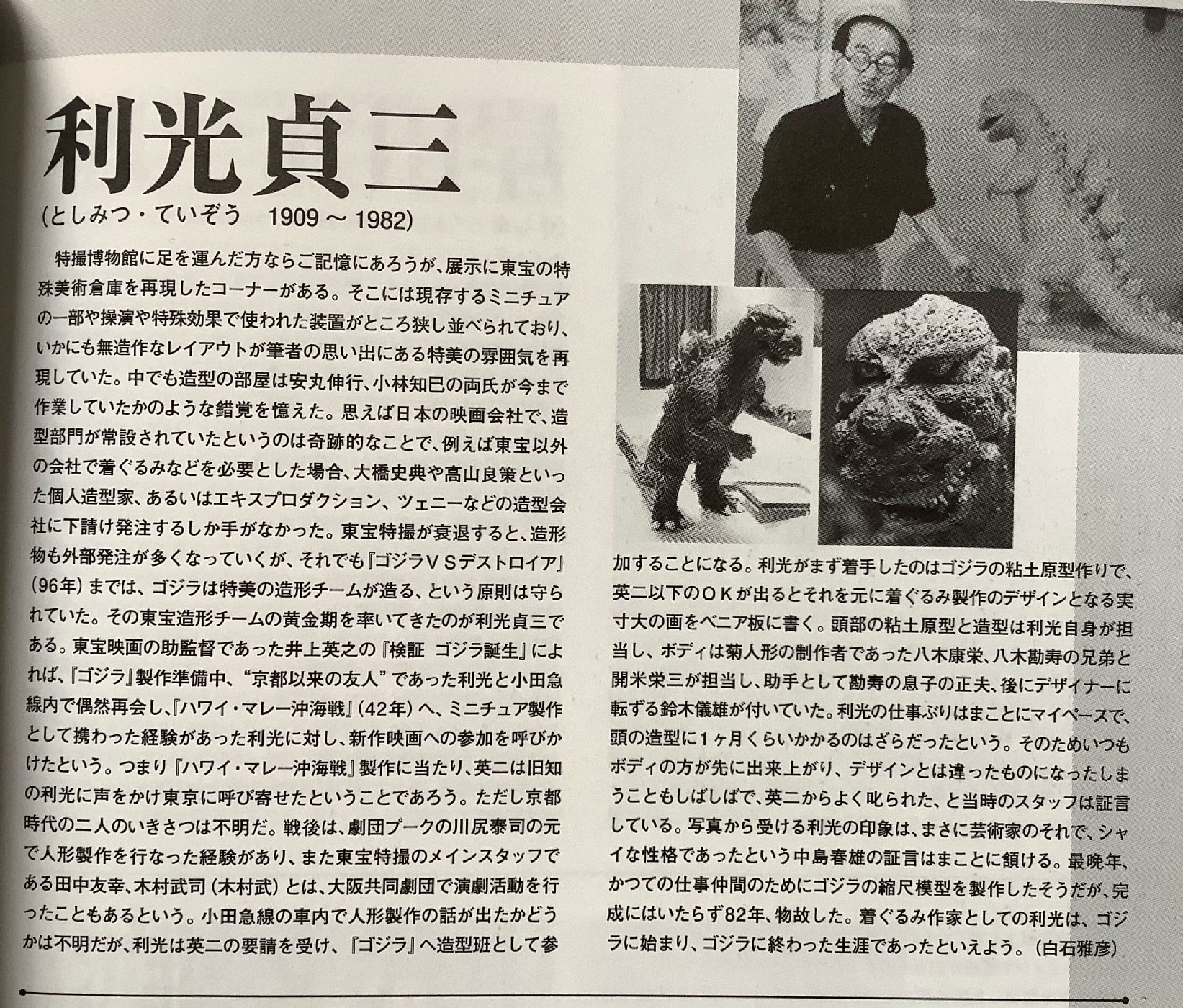3.6.2023
Teizo Toshimitsu

利光貞三
(としみつ • ていぞう 1909~1982)
Teizo Toshimitsu (1909~1982)
特撮博物館に足を運んだ方ならご記憶にあろうが、展示に東宝の特殊美術倉庫を再現したコーナーがある。そこには現存するミニチュアその一部や操演や特殊効果で使われた装置がところ狭し並べられており、いかにも無造作なレイアウトが筆者の思い出にある特美の雰囲気を再現していた。中でも造型の部屋は安丸伸行、小林知巳の両氏が今まで作業していたかのような錯覚を憶えた。思えば日本の映画会社で、造型部門が常設されていたというのは奇跡的なことで、例えば東宝以外の会社で着ぐるみなどを必要とした場合、大橋史典や高山良策といった個人造型家、あるいはエキスプロダクション、ツェニーなどの造型会社に下請け発注するしか手がなかった。東宝特撮が衰退すると、造形物も外部発注が多くなっていくが、それでも『ゴジラVSデストロイア』(96年)までは、ゴジラは特美の造形チームが造る、という原則は守られていた。その東宝造形チームの黄金期を率いてきたのが利光貞三である。東宝映画の助監督であった井上英之の『検証ゴジラ誕生』によれば、『ゴジラ』製作準備中、“京都以来の友人”であった利光と小田急線内で偶然再会し、『ハワイ・マレー沖海戦』(42年)へ、ミニチュア製作として携わった経験があった利光に対し、新作映画への参加を呼びかけたという。つまり『ハワイ・マレー沖海戦』製作に当たり、英二は旧知の利光に声をかけ東京に呼び寄せたということであろう。ただし京都時代の二人のいきさつは不明だ。戦後は、劇団プークの川尻泰司の元で人形製作を行なった経験があり、また東宝特撮のメインスタッフである田中友幸、木村武司(木村武)とは、大阪共同劇団で演劇活動を行ったこともあるという。小田急線の車内で人形製作の話が出たかどうかは不明だが、利光は英二の要請を受け、『ゴジラ』へ造型班として参加することになる。利光がまず着手したのはゴジラの粘土原型作りで、英二以下のOKが出るとそれを元に着ぐるみ製作のデザインとなる実寸大の画をベニア板に書く。頭部の粘土原型と造型は利光自身が担当し、ボディは菊人形の制作者であった八木康栄、八木勘寿の兄弟と開米栄三が担当し、助手として勘寿の息子の正夫、後にデザイナーに転ずる鈴木儀雄が付いていた。利光の仕事ぶりはまことにマイペースで、頭の造型に1ヶ月くらいかかるのはざらだったという。そのためいつもボディの方が先に出来上がり、デザインとは違ったものになったしまうこともしばしばで、英二からよく叱られた、と当時のスタッフは証言している。写真から受ける利光の印象は、まさに芸術家のそれで、シャイな性格であったという中島春雄の証言はまことに頷ける。最晩年、かつての仕事仲間のためにゴジラの縮尺模型を製作したそうだが、完成にはいたらず82年、物故した。着ぐるみ作家としての利光は、ゴジラに始まり、ゴジラに終わった生涯であったといえよう。(白石雅彦)
If you’ve been to the Tokusatsu Museum, you’ll probably remember that there is a corner that reproduces Toho’s special art warehouse in the exhibition. Some of the existing miniatures and equipment used for operations and special effects were lined up in a narrow space, and the casual layout reproduced the special atmosphere of the writer’s memories. Above all, I remembered the illusion that Mr. Nobuyuki Yasumaru and Mr. Tomoki Kobayashi were working on the modeling room. Come to think of it, it is miraculous that a Japanese movie company had a permanent modeling department. There was no choice but to subcontract orders to molding companies such as Production and Zeni. As Toho Tokusatsu declined, more and more sculptures were outsourced, but until “Godzilla vs. Destoroyah” (1996), the principle that Godzilla was made by Tokubi’s modeling team was kept. Teizo Toshimitsu led the golden age of the Toho modeling team. According to Hideyuki Inoue, who was an assistant director of Toho Films, “Verification of Godzilla’s Birth,” while preparing for the production of “Godzilla,” he happened to meet Toshimitsu, who was “a friend since Kyoto,” on the Odakyu Line, and “The War at Sea from Hawaii to Malaya.” Naval Battle” (1942), he called on Toshimitsu, who had experience in producing miniatures, to participate in the new film. In other words, it is likely that Eiji invited his old friend Toshimitsu to come to Tokyo for the production of “The War at Sea from Hawaii to Malaya.”
However, it is unclear what happened to them during their time in Kyoto. After the war, he had the experience of making puppets under Taiji Kawajiri of Gekidan Puku, and also worked with Tomoyuki Tanaka and Takeshi Kimura (Takeshi Kimura), the main staff of Toho Tokusatsu, at the Osaka Kyodo Theater Company.
It is said that there is also unknown whether or not there was talk of making dolls on the Odakyu Line, but Toshimitsu received Eiji’s request and participated in “Godzilla” as a modeling team. Toshimitsu first started making a clay prototype of Godzilla, and when Eiji or below got the OK, he drew a life-size drawing on a plywood board that would serve as the design for the production of the costume. Toshimitsu himself was in charge of the clay prototype and molding of the head, and the body was in charge of Yasuei Yagi, the brothers of Kanju Yagi and Eizo Kaimai, who were the creators of the chrysanthemum doll, and Masao, the son of Kanju, who later became an assistant. Yoshio Suzuki, who turned into a designer, was attached. Toshimitsu’s work was really at his own pace, and it is said that it was not uncommon for him to take about a month to model his head. As a result, the body was always completed first, and it often ended up being different from the design, and Eiji often scolded him, the staff at the time testified. The impression received from Toshimitsu’s photographs is that of an artist, and Haruo Nakajima’s testimony that Toshimitsu had a shy personality makes perfect sense. In his final years, he built a scale model of Godzilla for his former colleague, but it was never completed and he died in 1982. It can be said that Toshimitsu’s life as a costume designer started with Godzilla and ended with Godzilla. (Masahiko Shiraishi)
Tomoki Kobayashi (小林知己 Kobayashi Tomoki) was a Japanese sculptor and modeler. He served as Toho’s third and final chief modeler, after Nobuyuki Yasumaru. (Source: Wikizilla https://wikizilla.org/wiki/Tomoki_Kobayashi)
Nobuyuki Yasumaru (安丸信行 Yasumaru Nobuyuki) was a Japanese monster modeling artist and sculptor. He served as Toho’s chief modeler between 1971 and 1991, succeeding Teizo Toshimitsu. He passed away on March 1, 2022, at the age of 87. (Source: Wikizilla https://wikizilla.org/wiki/Nobuyuki_Yasumaru)
エキスプロダクション (EX PRODUCTION) is a Japanese modeling production company. The current location is Shibasaki, Chofu City, Tokyo. In 1966, Masao Yagi, Keizo Murase, Akira Suzuki, and others who participated in the modeling of Daiei’s special effects movie “Gamera” were established as a modeling company specializing in special effects. Yagi served as the representative director, Murase was in charge of modeling art, and Suzuki was in charge of special effects. The company name means “expert group” and was named by Murase. (Source: Wikipedia https://ja.wikipedia.org/wiki/エキスプロダクション)
Zeni (ツエニー) was established in 1972 by Keizo Murase, a sculptor belonging to Ex Productions. When Murase established Ex-Production, he declared that he would become independent after raising six assistants, and he made it happen. In addition to modeling special effects works, he also works on theme park attractions. As of 2022, the founder, Tsuguzo, has become the chairman, and his son Naoto Murase, a company staff member, has taken over as representative director. (Source: Wikipedia https://ja.wikipedia.org/wiki/ツエニー)
The War at Sea from Hawaii to Malaya (ハワイ・マレー沖海戦, Hawai Mare Oki Kaisen) is a 1942 black-and-white Japanese war film directed by Kajiro Yamamoto, with special effects by Eiji Tsuburaya. (Source: Wikipedia https://en.wikipedia.org/wiki/The_War_at_Sea_from_Hawaii_to_Malaya)
Puk Pupa Teatro (劇団プーク). PUPPET THEATRE PUK (LA PUPA KLUBO in Esperanto) was founded by the late Toji Kawajiri, the elder brother of PUK’s Artistic Director the late Taiji Kawajiri(1914-1994), in 1929, the same year as UNIMA foundation. (Source: Puppet Theatre PUK https://puppettheatrepuk.wordpress.com/about/)
Takeshi Kimura was a Japanese screenwriter. Kaoru Mabuchi (馬淵 薫, Mabuchi Kaoru, February 4, 1911 – May 3, 1987), better known by his pen name Takeshi Kimura, was a Japanese screenwriter who wrote many films for Toho studios. Kimura scripted several films for director Ishirō Honda, including Matango, Frankenstein vs. Baragon, The War of the Gargantuas, King Kong Escapes, and Destroy All Monsters. (Source: Wikipedia https://en.wikipedia.org/wiki/Takeshi_Kimura)
Kanju Yagi (八木 勘寿 Yagi Kanju) and Yasuei Yagi (八木 康栄 Yagi Yasuei), known collectively as the Yagi brothers (八木兄弟 Yagi kyōdai), were Japanese sculptors and modelers. (Source: Wikizilla https://wikizilla.org/wiki/Kanju_Yagi_and_Yasuei_Yagi)